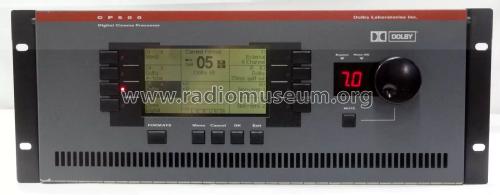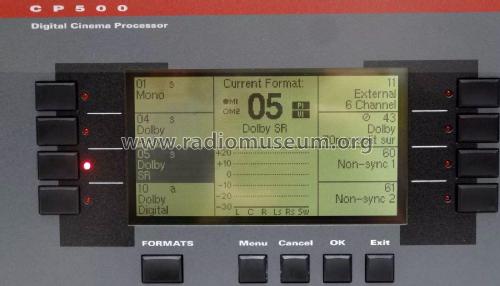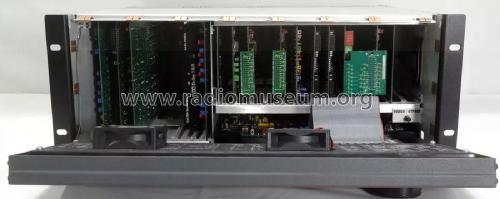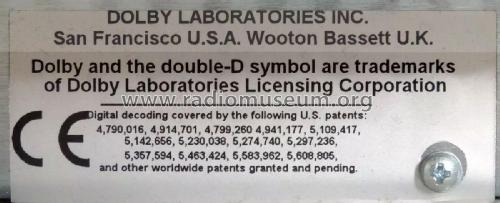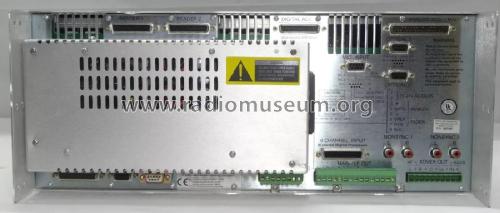Digital Cinema Processor CP500
Dolby Laboratories, Inc.; San Francisco, CA
- Country
- United States of America (USA)
- Manufacturer / Brand
- Dolby Laboratories, Inc.; San Francisco, CA
- Year
- 1998 ?
- Category
- Audio Amplifier or -mixer
- Radiomuseum.org ID
- 359004
- Number of Transistors
- Semiconductors present.
- Semiconductors
- Main principle
- Audio-Amplification
- Wave bands
- - without
- Power type and voltage
- Alternating Current supply (AC) / 50 - 60 Hz, 100 - 240 Volt
- Loudspeaker
- - Is a Headphone or Earphone
- Material
- Metal case
- from Radiomuseum.org
- Model: Digital Cinema Processor CP500 - Dolby Laboratories, Inc.; San
- Shape
- Miscellaneous shapes - described under notes.
- Dimensions (WHD)
- 493 x 178 x 360 mm / 19.4 x 7 x 14.2 inch
- Notes
-
The Dolby CP500 Digital Cinema Processor is a versatile and advanced audio processing unit designed for cinema sound systems. It combines both digital and analog technologies to provide high-quality audio processing for various film formats.
Key Features:
- Compatibility: Supports Dolby Digital, Dolby A-type, and Dolby SR analog soundtrack decoding.
- Input Options: Includes optical inputs for two projectors, magnetic/auxiliary inputs, non-sync inputs, microphone input, and digital reader inputs.
- Output: Provides 6-channel output for left, center, right, left surround, right surround, and subwoofer speakers.
- Audio Processing: Utilizes digital implementation for third-octave speaker equalization and 2:4 matrix decoding, while employing high-performance analog circuitry for Dolby A-type and SR decoding.
- Equalization: Features 27-band digital 1/3 octave EQ for L, C, R channels, 9-band full octave EQ for surround channels, and digital parametric EQ for subwoofer.
Technical Specifications:
- Dimensions: 4U rack-mount chassis, 178 mm (h) x 493 mm (w) x 360 mm (d).
- Weight: 11.7 kg (26 lbs)
- Power Requirements: 100-240 VAC, 50-60 Hz auto-sensing, 120 Watts max.
- Dynamic Range: Typically, 92 dB with the fader set to 7.0
- Distortion: Typically, 0.05% in Dolby SR mode.
- Operating Conditions: 0-40°C, 20-80% humidity, non-condensing.
Additional Features:
- User Interface: LCD screen and simplified front panel for easy operation.
- Automation: Supports direct mode with eight contact closures and sequential mode for pre-programmed formats.
- Remote Control: Connections for up to two remote fader and format selectors.
- Upgradability: Software updates can be easily downloaded from a PC.
- Built-in Diagnostics: Enables theatre staff to verify the performance of the complete theatre sound system.
The CP500 is available in different configurations to suit various cinema needs, including CP500-D, CP500-D/300, CP500-SR, and CP500-70, offering flexibility in terms of decoding capabilities and magnetic soundtrack support.
Optional Features:
- Cat. No. 683 Optional XO Card: An internal Linkwitz-Riley crossover network for bi-amplified screen speakers, providing separate speaker crossover for Bypass operation and allowing augmentation of surround speakers with bass speakers.
- Cat. No. 685 6-Channel Analog to Digital Converter Card: Allows for external 6-channel input.
- Cat. No. 670 Video Front-End Card: Part of the Dolby Digital soundtrack processing system.
- Cat. No. 671 DSP Cards: Two cards used in the Dolby Digital soundtrack processing system.
- Cat. No. 673 System Services Card: Component of the Dolby Digital processing system.
- Cat. No. 680 Bit Rate Converter Card: Part of the Dolby Digital processing system.
These options and configurations allow for customization of the CP500 to meet specific cinema audio processing requirements, ranging from different decoding capabilities to support for various soundtrack formats.
- Net weight (2.2 lb = 1 kg)
- 26 lb (26 lb 0 oz) / 11.804 kg
- Mentioned in
- - - Manufacturers Literature (Installation & Alignment Manual for the CP500, Issue 5.)
- Author
- Model page created by Gary Cowans. See "Data change" for further contributors.
- Other Models
-
Here you find 3 models, 3 with images and 0 with schematics for wireless sets etc. In French: TSF for Télégraphie sans fil.
All listed radios etc. from Dolby Laboratories, Inc.; San Francisco, CA
